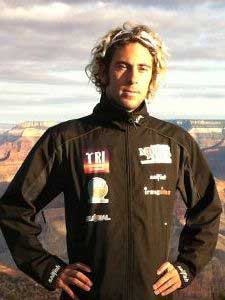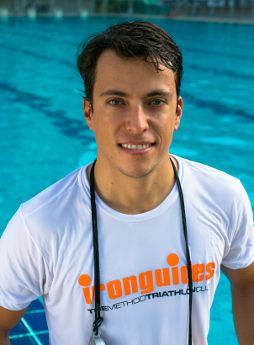ironguides Coach Alun ‘Woody’ Woodward:
 Bevan and Vanessa Colless from Australia run a couple of physio clinics in Japan and have recently set up practice in Singapore. They also train and compete at the top of the age group ranks and are both heading to Kona this year. Both athletes are very focused and goal-oriented and have worked hard since taking up triathlon in 2005 to get to this point.
Bevan and Vanessa Colless from Australia run a couple of physio clinics in Japan and have recently set up practice in Singapore. They also train and compete at the top of the age group ranks and are both heading to Kona this year. Both athletes are very focused and goal-oriented and have worked hard since taking up triathlon in 2005 to get to this point.
PROFILE
Bevan:
My first race was Phuket Tri in 2005. My first Ironman was Vineman in 2009. I have finished 10 Ironmans, started 13.
My background was in soccer and rugby. I first started with ironguides in 2009 when we signed up for our first Ironman.
I never swam at school but, like all Aussies, I swam in friends’ pools and on family holidays at the beach, and I would body surf a lot on holidays. Never did laps though.
My Dad was/is a bicycle tragic. His house has little model bikes everywhere—people give them to him as presents all the time now. He had a bike printed on his wall for years, cycled to work every day for 30 years and took us all (six kids of which I was the youngest) on bike holidays; my Mum would drive the wagon and the kids would ride point to point from campsite to campsite. When I was 16, Dad and I did a charity ride from Sydney to Melbourne (1,000km).
I was a cross-country runner at school, top 10 in the state (NSW) for most of my high school years, until I discovered beer, girls, and played soccer and rugby for 20 years.
Vanessa:
My first triathlon was in Phuket in 2006. My first Ironman was in Western Australia in 2009.
At school I did mostly gymnastics and diving. I loved doing sport so I participated in many other sports—tennis, water skiing, track & field, netball. After leaving school, I continued some kind of fitness by doing a few weights at the gym and running 20 to 40 minutes twice a week. I had never done any endurance type of sport. The longest run I had pretty much done was 10km.
I started triathlons in mid-2006. This was after I found this email in my inbox saying “Thank you for entering Laguna Phuket triathlon…”
My husband had kindly entered me without my knowledge!
I had seen my husband doing triathlons over the past year, so I knew a little bit about what was involved. I was a little concerned as I had not swam since school sports classes and I did not have a bike. So the next day I went to the pool and swam the distance. My confidence grew.
I thought I will buy a bike and start training, then decide closer to the race if I will do it.
The triathlon came before I knew it; I thought why not give it a go, my husband is doing it.
I really had little idea at this stage, I don’t recall taking any nutrition, I just had a drink bottle. I completed the race with a reasonable place in my age group. This was the beginning of a new lifestyle. I could see there was room for improvement so I wanted to do more triathlons: I loved the idea of doing something healthy, it is a good way to make an excuse for a holiday, and it was also something my husband and I could do together.
 Also, our dog loves the training: he swims alongside me when I am in open water. He runs with me outside, and on the treadmill next to me when I am biking on the Computrainer.
Also, our dog loves the training: he swims alongside me when I am in open water. He runs with me outside, and on the treadmill next to me when I am biking on the Computrainer.
I did mostly local Olympic-distance triathlons in Japan for the first two years. At this stage I thought Ironman distance was totally amazing—I never thought it would be something I would ever do.
My husband was slowly getting more serious in his training and increasing the distance of his races—and entering me in these races as well so I was also increasing my distances.
Before I knew it, my husband was now thinking of giving the Ironman distance a go. It was around this stage we joined ironguides. ironguides certainly changed our training and improved our performances. I completed my first Ironman in Western Australia in 2009. It was a big day but not as hard as I imagined. Since then I have done at least half a dozen Ironmans around the world (Roth, Challenge Copenhagen, Ironman Austria, Ironman WA three times, Ironman Regensburg twice, Ironman Japan, Kona—wow that’s the first time I have actually put them down and counted, 10!).
I had a hiccup in 2011 when I had a bicycle accident the day before Ironman UK. I had to have a lot of teeth reconstruction work. My confidence to continue in the sport was crushed. I had lost confidence on the bike, I was worried about being hit in the mouth in the swim and I had lost fitness. My coach Woody slowly rebuilt my confidence. I returned to training pretty fast and decided that if I am going to return, I want to return to do well.
My goal to get to Kona only really developed after coming close to qualifying. When I could see that it was within my reach, my drive to get it developed. I qualified in 2012.
COACHING
Woody:
When I started working with Bevan and Ness, it was clear very early they were high performance athletes and willing to work very hard to achieve their goals. While Bevan was quite clear on what this target was, Ness was more reserved in her goals!
As I have found with all such dedicated athletes, they are always wanting to do more and go faster in training: my main challenge as a coach was getting them to train at an appropriate volume for their development and put a program in place that would see them improve year after year and maintain motivation and health so they could achieve their goals.
Also, due to their jobs and a lot of traveling it was important to have a plan that could be flexible around travel but always working on a basic template to ensure development. I think we did a great job of this over the years and avoided injuries and illness.
From the very start, development of strength—not endurance—was my goal. Most athletes think endurance is what they need for Ironman. It was good to start with them early in their triathlon careers and see how well this approach has worked.
Tools of the trade
Bevan and Ness are very different in their approach to training: Ness will follow effort and time and does not use a Garmin, power meter or heart rate monitor, while Bevan likes to see the numbers and uses tools to his advantage—more to stop himself going too hard than as a guide in training!
RACING
Racing for Bevan and Ness was about enjoying travel and doing iconic races to start with. They did some great races and when seeing the level of performance they were capable of, the focus moved to looking at qualification races. I think they are both very versatile racers and capable of qualifying in most races but weather was a big factor in performance for them both.
With Ness weighing just 42kg and very little body fat, racing in the cold was just not going to work: this factor has affected many of Ness’s results over the years but a hot race in Kona is perfect for her so I am excited to see what she can do this year!
Bevan on the other hand is a heavier athlete and suffers in the heat so a cooler race, especially on the run, was always going to suit best in order to prevent the big fall-off in pace over the last 20km of the marathon that we typically see in hot races as core temperature just goes too high.
Another factor we had to look at with Bevan was natural speed. He is a fast athlete and it’s too easy for him to go too fast when feeling good, which impacts him later in the race. We use a Garmin on the run to limit the pace, especially over the first 5km of the run—when this plan is followed, a good run and race tend to follow! Using a power meter as a limiter recently has also seen Bevan produce some amazing bike splits.
CAMPS
With the nature of Bevan and Ness’s work we have used training camps a lot over the years. They would typically be 10 days of focused work where life was JUST triathlon—these really worked well for boosting endurance and confidence heading into their main races.
One of my favourite camps was for Bevan in Hawaii last year—he missed qualification in 2012 due to his choice of not carrying tools with him in more than one race, so he was punished when watching Ness race in Hawaii.
This camp was a little harder than sensible for sure but the form Bevan was carrying coming out of the camp was amazing, to the point that he was making some of the pros question their career choice when riding with them!
QUALIFICATION
Ness qualified winning her age group in Ironman WA by an amazing 30 minutes, just a solid performance over the whole day.
Bevan secured his qualification in Canada with a devastating swim and bike performance coming off the bike in 14th place overall and then just needing to cruise around the run to qualify!
 Alun ‘Woody’ Woodward, Certified ironguides Coach –
Alun ‘Woody’ Woodward, Certified ironguides Coach –
http://www.ironguides.net
* * * Your best is our business.™ * * *









Recent Comments